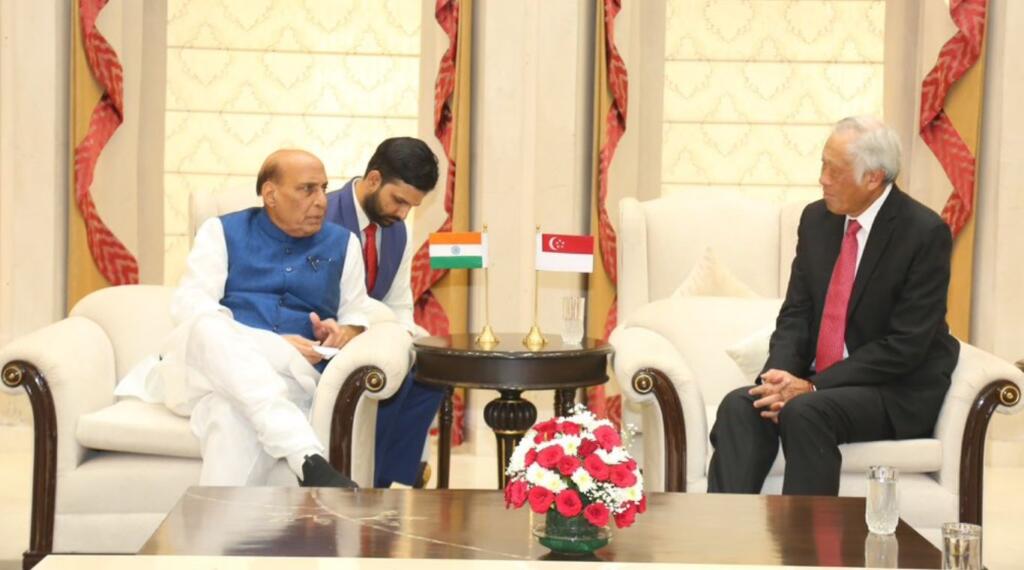India and Singapore held the sixth bilateral Defence Ministerial Dialogue in New Delhi on October 22, renewing the joint military training exercise for another five years. In the process, India cemented its strategic defence diplomacy in the Southeast Asian region.
The dialogue is part of India’s continuing exercise to form deeper partnerships with key Southeast Asian countries, leading with Singapore and followed by Vietnam and The Philippines. New Delhi is intent on China’s expansionist and interfering policies in the Indo-Pacific that do not affect Indian interests and undermine the rules-based order in the region.
The Dialogue was co-chaired by Defence Minister Rajnath Singh and visiting Singaporean counterpart Ng Eng Hen. The agreement allows both armies to train together in India.
It comes close on the heels of both countries set to celebrate 60 years of official bilateral ties in 2025.
The two countries will now join hands to focus on emerging technologies and defence industry cooperation, as well as the potential for Singapore to use India’s Chandipur Integrated Test Range for live firing of weapon systems.
The Republic of Singapore Navy and the Indian Navy recently concluded the 30th Singapore-India Maritime Bilateral Exercise in the southern reaches of the South China Sea, within international waters. It is the Indian Navy’s longest uninterrupted bilateral maritime exercise with any foreign navy. Both air forces also hold regular bilateral exercises.
Last month, Prime Minister Narendra Modi was in Singapore on an official visit. Both elevated bilateral ties to a comprehensive strategic partnership, strengthening their commitment to the Comprehensive Economic Cooperation Agreement that India and Singapore signed in 2005.
Singapore understands the value of the Indian partnership. Deputy Prime Minister Heng Swee Keat said in September that for Asia to navigate the complex growth path ahead and harness the power of technology and innovation for a better future, it is critical to deepen understanding and strengthen trust, given the “complex and diverse configuration of nation states” in the region.
India’s increased defence and security engagement with Southeast Asian countries has increased as China’s intrusion in the Ladakh region began in 2020. An article in the International Institute for Strategic Studies pointed out that the border clashes in 2020 widened the trust deficit between New Delhi and Beijing and added to the geopolitical polarisation of South and Southeast Asia.
Since 2020, the main development in India’s defence policy vis-à-vis Southeast Asia has been its increased engagement with ASEAN. Significantly, in November 2022, the first ASEAN–India Defence Ministers’ Informal Meeting was held in Cambodia on the sidelines of the ASEAN Defence Ministers’ Meeting Plus. The two sides identified areas to strengthen collaboration. The meeting was a clear indication to Beijing that India wanted to step up its defence cooperation with ASEAN and ASEAN member states.
India and ASEAN states held their inaugural maritime exercise in the South China Sea in May 2023. India is the fourth country to hold a joint exercise with ASEAN, after China, Russia, and the United States. Seven ASEAN states provided naval ships: Brunei, Indonesia, Malaysia, the Philippines, Singapore, Thailand, and Vietnam. Brunei’s participation was notable, as India and Brunei have never held a naval exercise bilaterally.
After a series of defence agreements and the export of arms, India currently views the region as a more viable market for its arms exports. Along with defence exports, India has stepped up its defence engagement with the ASEAN to demonstrate that it wants to engage with all countries in the region.
The defence and maritime security cooperation between India and ASEAN and Southeast Asian states help New Delhi support its territorial claims in the South China Sea more vocally. In the process, it enables India to counter China’s regional influence and its activities that might threaten India’s freedom of navigation.
Singapore’s diplomatic prowess has been instrumental in guiding ASEAN’s strategies, emphasising economic development and openness. Its strategic positioning as a neutral and stable force in a region marked by intense geopolitical complexities has enabled the maintenance of balanced relations with major global powers, including the United States and China. This approach aligns closely with India’s diplomatic approach globally.
In Southeast Asia, this enhances India’s ability to partner with Singapore in navigating the intricate power dynamics of the region, enabling it to engage with various countries on its own terms while contributing to regional stability. The continued strengthening of this relationship will be vital in advancing India’s Act East policy in the years to come and in securing its long-term imperatives in the Indo-Pacific.
The bilateral pact has borne fruit for New Delhi. Singapore’s diplomatic prowess has been instrumental in guiding ASEAN’s strategies, emphasising economic development and openness. As a neutral and stable force in this complex region, it has succeeded in maintaining balanced relations with major global powers, including the United States and China. This approach aligns with India’s diplomatic approach globally.
As media analysts note, this also enhances India’s ability to partner with Singapore in navigating the intricate power dynamics of the region, enabling it to engage with various countries on its own terms while contributing to regional stability.
